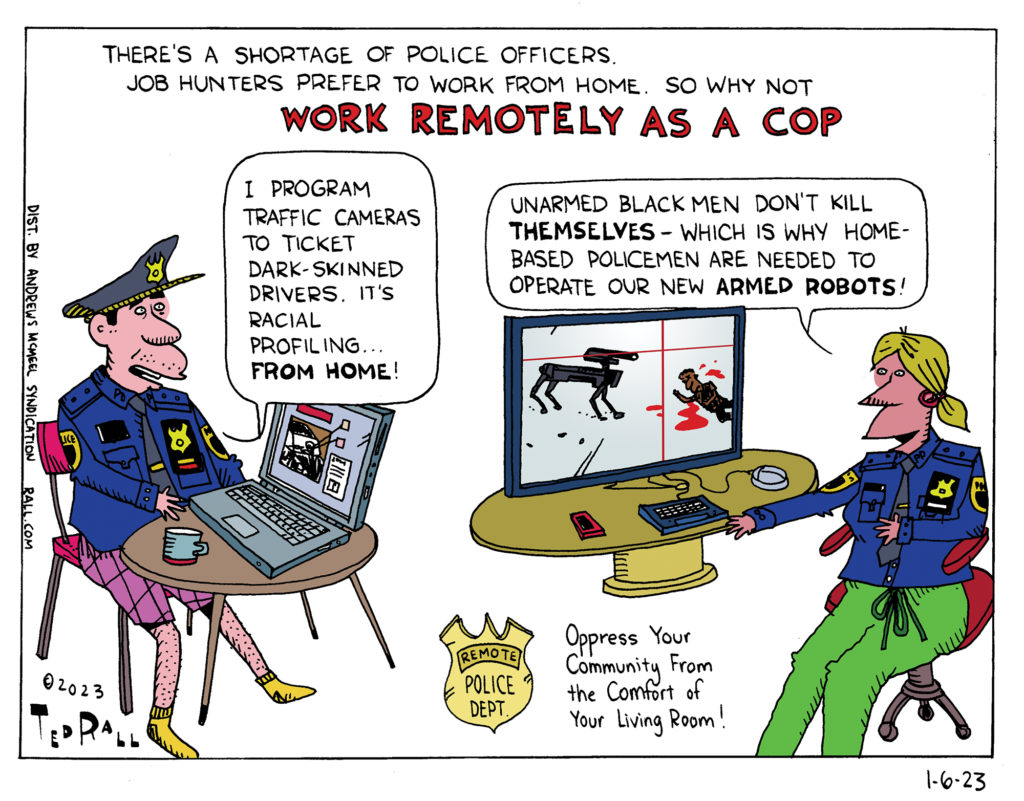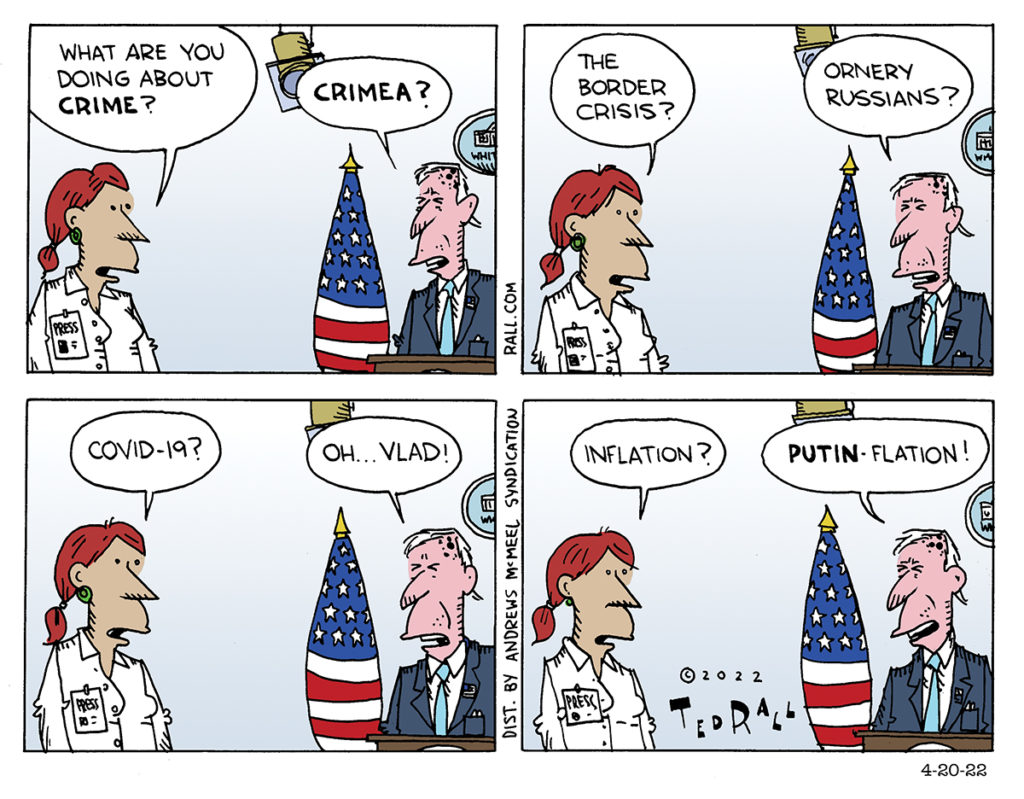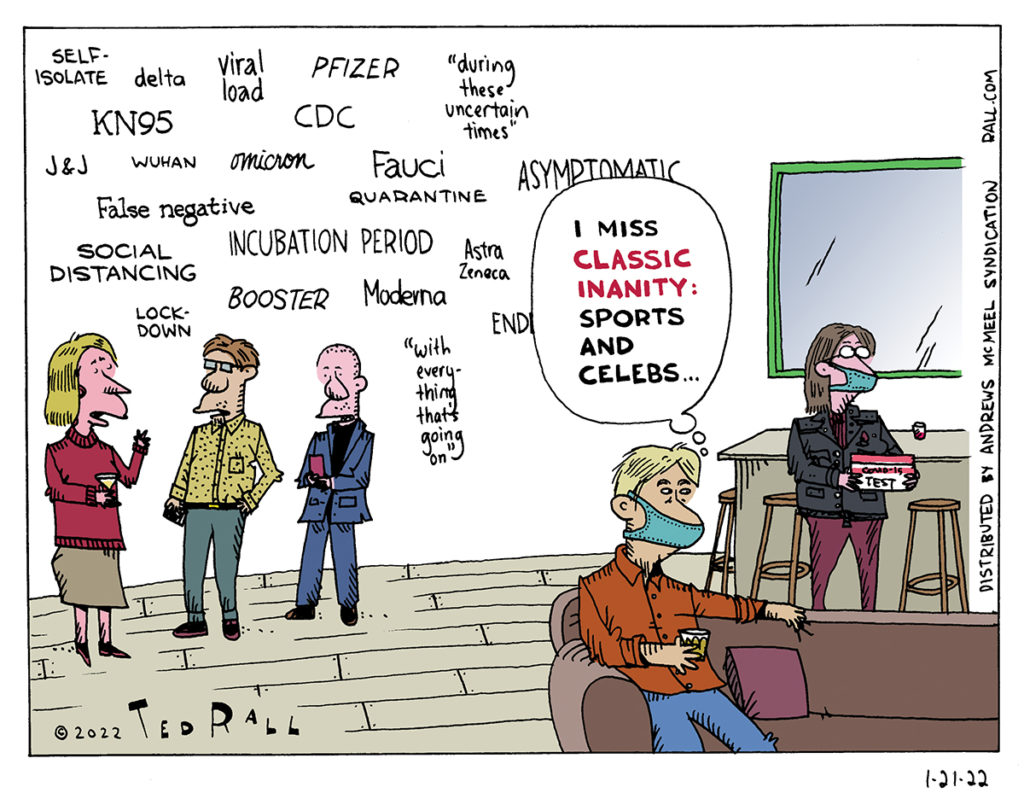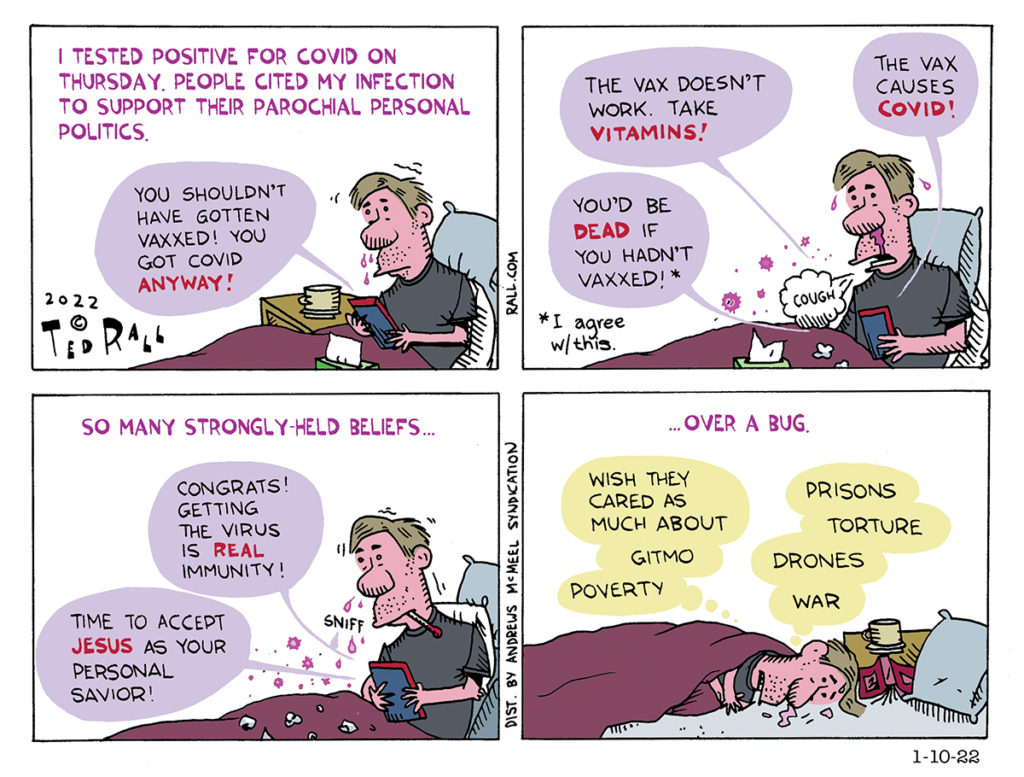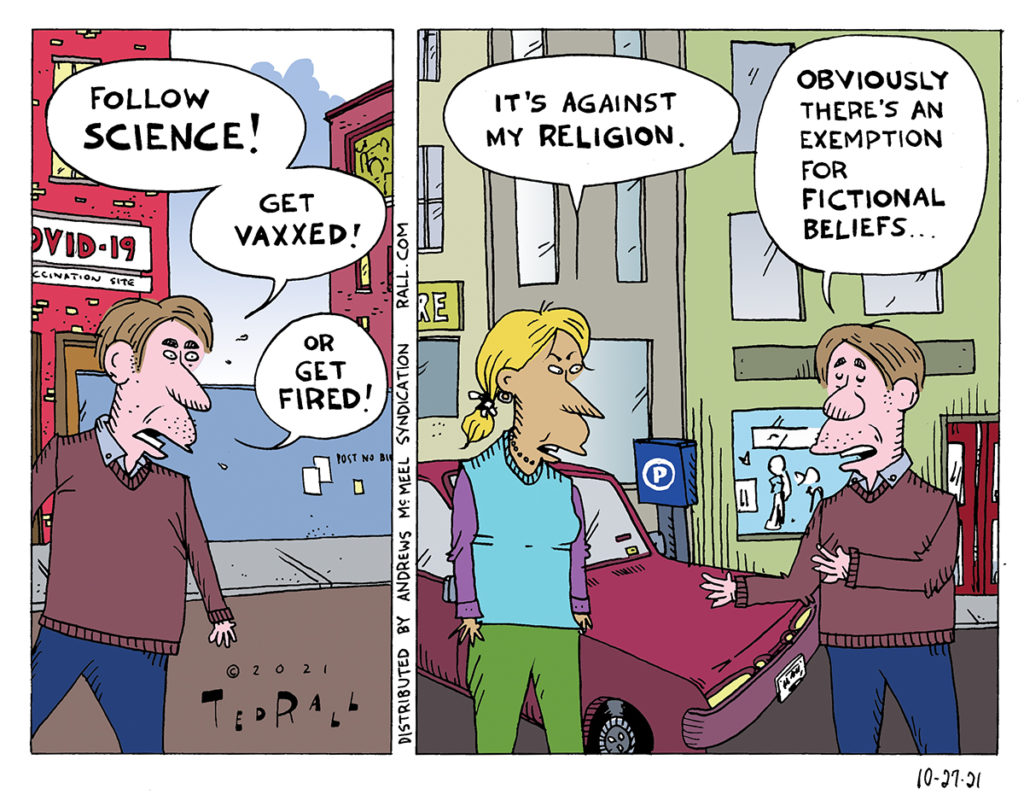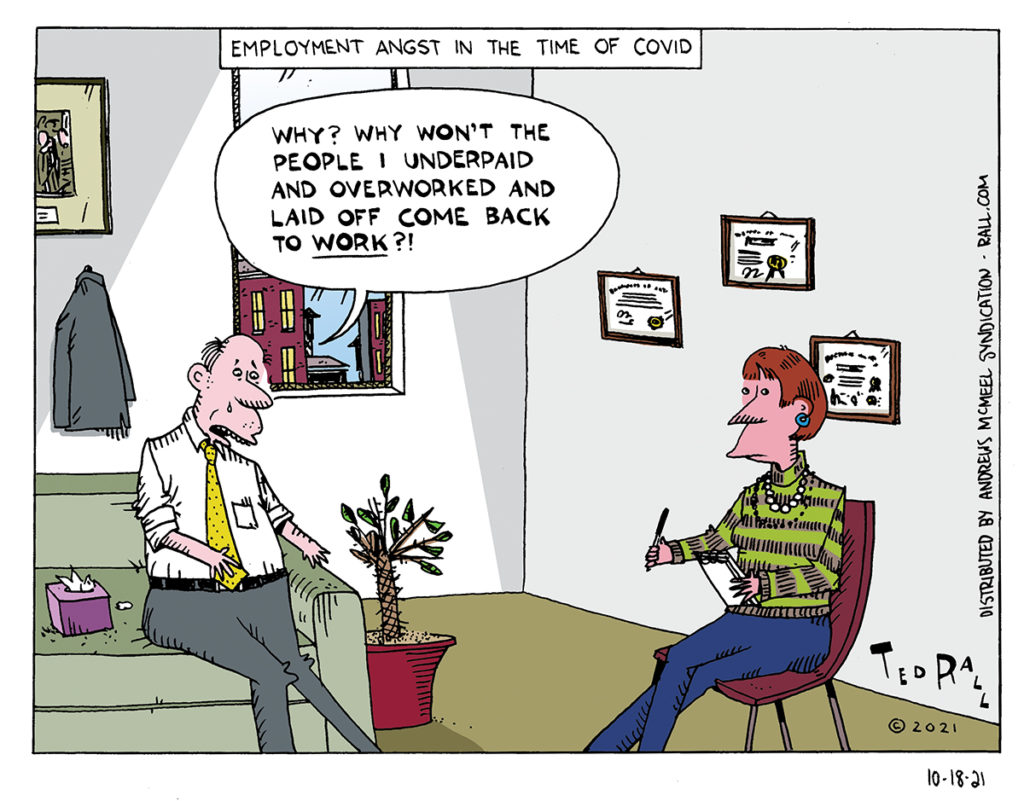Police departments are having trouble recruiting new members. Many unemployed people prefer to work from home. Now there’s a solution: work as a cop, from home!
When It Cares, the U.S. Government Is Extremely Efficient

As the COVID-19 pandemic has made painfully clear, our healthcare system is a disaster. 12% of Americans are uninsured and 21% are underinsured. Many counties have zero or just one healthcare plan on offer through their local ACA marketplace, so there is no price competition whatsoever. Due to the lack of competition, and price gouging, by for-profit insurers, the average family of four who buys insurance through Obamacare pays a whopping $25,000 a year in premiums and deductibles—more than a third of their income after taxes.
More than 18,000 Americans die annually due to lack of medical insurance.
This is very sad, especially for them and their families. But nothing can be done about it. Lame as it is, the Affordable Care Act is as good as it gets. Until the Republicans get back in charge, when they will try to get rid of it again. Political dysfunction, amirite?
When they care about something, however, the U.S. government can be incredibly efficient.
The U.S. government really cares about war.
Just two days after Russia invaded, President Biden signed a memo authorizing the transfer of $350 million of weapons to Ukraine. Within three weeks, almost all the antitank weapons, kamikaze drones and other war materiel had arrived in Ukraine. That’s less time than it takes first-class mail to get to some places within the United States.
If you are sick and uninsured, consider a move to Kyiv. As we saw in Afghanistan, U.S. weapons have a habit of disappearing and being sold for profit in war zones. If you still have enough energy and a little luck, you might be able to pilfer one of those American-made radar systems or a few boxes of grenade launchers to finance your chemotherapy. Even if not, Ukraine offers something the United States probably never will: a universal healthcare system.
Out-of-control college tuition costs have pushed 9 million young borrowers and their families into default on $124 billion in student loans. 80% of these young men and women came from families with total incomes under $40,000; so they’re not deadbeats, they’re poor. The burden of student loan debt hobbles America’s best and brightest just as they are starting out their adult lives. They defer or never purchase homes and cars, and are unable to save for retirement. This hurts the real estate, automobile and durable-goods businesses and turns many talented people into future welfare recipients.
This is highly unfortunate, especially for them and their families. But nothing can be done about it. Lame as it was, President Biden’s campaign promise to cancel $10,000 in student loan debt was as good as could be hoped for. And he never followed through. Responding to pressure from Republicans and right-wing Democrats, Biden’s latest federal budget, for 2022, doesn’t contain any provisions for student loan forgiveness. They said they were too worried about the deficit.
Republicans and right-wing Democrats, on the other hand, only worry about the deficit sometimes. Liberals, conservatives, Democrats, Republicans and every other strain of American House representative and Senator quickly approved an additional $13.6 billion in military aid to Ukraine less than a month after the first shipment of cash. There was strong bipartisan support for the measure, which was immediately signed into law by President Biden. Yay, America!
So don’t despair if you are broke, defaulting on your student loans and unable to escape poverty because even under bankruptcy you can’t get rid of student debt. Scrape up whatever money you still have and hop a plane to Ukraine. Even for non-Ukrainian citizens, total cost of tuition, housing, food, books and other fees at colleges and universities in Ukraine rarely exceed $4000 a year — and they’re usually cheaper. Alternatively, you can try to pass yourself off as Ukrainian at Texas A&M or Hampton University in Virginia, both of which now offer free room, board and tuition to Ukrainian nationals. Americans, of course, need not apply.
One out of six American children, 12 million total, officially live in poverty. Neither political party seems much to care, and child poverty has not been a major campaign issue in decades. So the problem continues to worsen.
This is a total bummer, especially for the kids and their families. But nothing can be done about it. Republicans and right-wing Democrats vote against child tax credits, citing the need to balance the budget and concerns that some parents might not use the money to take care of their kids.
But the budget doesn’t always matter. Nor is careful stewardship of public funds always a priority. When the need is great, both parties come together and overlook such trivialities. President Biden, with the support of Republicans, liberal Democrats and right-wing Democrats, just announced an additional $800 million in military aid to Ukraine, bringing the total to more than $2.5 billion. Who cares if some of that gear winds up in the hands of neo-Nazis? In $100 bills, the cash would weigh 25 tons.
Those who criticize the United States government as inefficient couldn’t possibly be more mistaken. Congress and the White House are lightning quick and incredibly generous—when it matters.
(Ted Rall (Twitter: @tedrall), the political cartoonist, columnist and graphic novelist, is the author of a new graphic novel about a journalist gone bad, “The Stringer.” Order one today. You can support Ted’s hard-hitting political cartoons and columns and see his work first by sponsoring his work on Patreon.)
Corporate Journalists are Blind to a Big COVID Lesson
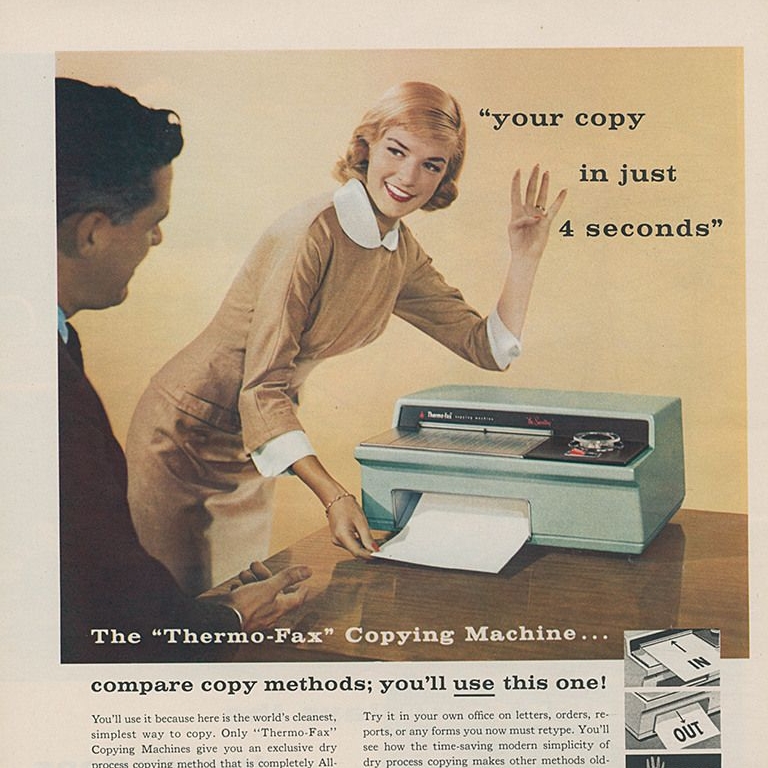
One of my complaints about mainstream media is that they recruit reporters from inside the establishment—Ivy League colleges, expensive graduate journalism programs, rival outlets with similar hiring practices. Some staffs develop admirable levels of gender and racial diversity. But they all come from the same elite class. Rich kids believe in the system and they accept its basic assumptions.
On New Year’s Day a reporter (UPenn and Oxford, of course) published a solid piece for The Washington Post about an important issue, how America’s “fractured healthcare system” hurts our response to COVID-19. Seeking to answer the question of why the pandemic is still going on after the miraculously rapid development and distribution of vaccines, the Post identified organizational shortcomings as part of the problem, citing the need for “improvements on the delivery side.” She quoted an expert who called for “increasing staffing and funding for local health departments, many of which have been running on a shoestring. Officials in some local health departments still transfer data by fax.” Both true. I’ve been asked to fax my records recently.
But.
Nowhere in the Post piece was there any mention of what the United States is missing that most other countries in the world are not: a unified national healthcare system like the United Kingdom’s NHS.
I’m not talking here about fully-socialized medicine or a single-payer Medicare For All system like the one championed by Bernie Sanders, although I strongly believe Americans need and deserve one. This isn’t about who pays for healthcare (though it should obviously be covered 100% by the government).
It’s about data integration.
In the same way that law-enforcement agencies across the country can access criminal records from other jurisdictions via the FBI’s National Data Exchange system, public-health officials need access to a real-time, constantly-updated source of every report of disease whether it’s known or novel, the visit was paid for in cash by the patient or covered by insurance, or it was diagnosed by a country doctor, walk-in urgent-care center or a giant urban hospital system.
A fully-integrated national healthcare database would be a powerful side benefit of a national healthcare system like Medicare For All. But how likely is Bernie Sanders’ pet project to cross the mind of a writer who graduated from UPenn and Oxford and has a gold health insurance plan provided by her employer, who is Jeff Bezos?
Here in America, the nation’s top epidemiologists at the Centers for Disease Control are flying blind, relying on algorithmic models that estimate what’s going on rather than providing accurate, precise situational awareness.
I tested positive for COVID-19 on December 30. I notified my doctor’s office on January 1 but due to the holiday didn’t hear back until January 3. Will New York City authorities and/or the CDC be notified about my case and, if so, when?
Several friends and friends of friends also tested positive during the Omicron surge using home tests. Many, probably most, didn’t tell their doctor. You have to assume that official numbers for Omicron have been significantly underreported.
If we had a national healthcare system instead of a medical Wild West in which the ailing are jostling against each other fighting over $24 testing kits like shoppers rushing into Best Buy on Black Friday, testing would be handled through clinics and doctor’s offices in coordination with the federal government—which would instantly compile the results.
A national healthcare database could include “visualization tools to graphically depict associations between people, places, things, and events either on a link-analysis chart or on a map. For ongoing investigations, the subscription and notification feature automatically notifies analysts if other users are searching for the same criteria or if a new record concerning their investigation is added to the system… [allowing] analysts to work with other analysts across the nation in a collaborative environment that instantly and securely shares pertinent information.”
I lifted that last quote from an FBI description of their police database. Crime, by the way, kills a small fraction of the number of Americans who die from disease.
HIPAA regulations governing patient records would need to be modified by Congress, but consider the potentially lifesaving benefits even when there is no longer a pandemic. Medical errors are the third leading cause of death in the United States.
Decentralized recordkeeping is a public-health disaster. If you live in Wyoming, there is no good reason that your healthcare records shouldn’t be accessible to first responders driving the ambulance that responds to a call that you collapsed and are unconscious at a mall in Florida. As soon as you are identified—something that could be facilitated by a national healthcare ID card that you carry in your wallet or as an app on your smartphone—EMS workers could use your patient history to identify chronic problems. They could avoid a medication to which you might be allergic or feel confident in administering one thanks to the knowledge that you are not.
I didn’t go to UPenn and Oxford. As an independent writer, I pay my own health insurance. I am reminded of America’s crappy healthcare system every time I pay my ACA bill and every time I cough up a co-pay. Newspapers like the Post may or may not need me. But they definitely need people like me if they want to relate to the readers they’re trying to serve.
(Ted Rall (Twitter: @tedrall), the political cartoonist, columnist and graphic novelist, is the author of a new graphic novel about a journalist gone bad, “The Stringer.” Order one today. You can support Ted’s hard-hitting political cartoons and columns and see his work first by sponsoring his work on Patreon.)
DMZ America Podcast #28: Looking Back at 2021, Predicting 2022 and Beyond (and Ted has Covid)
For the last podcast of the year, Scott and Ted look back at the year that was and consider the world of politics and culture in the year ahead and beyond. From January 6 to the midterms to scary prospects for Democrats in 2024, we don’t hesitate to speculate. Also, Ted has Covid.
Our First Lockdown Experiment Failed. Let’s Not Try a Second One.
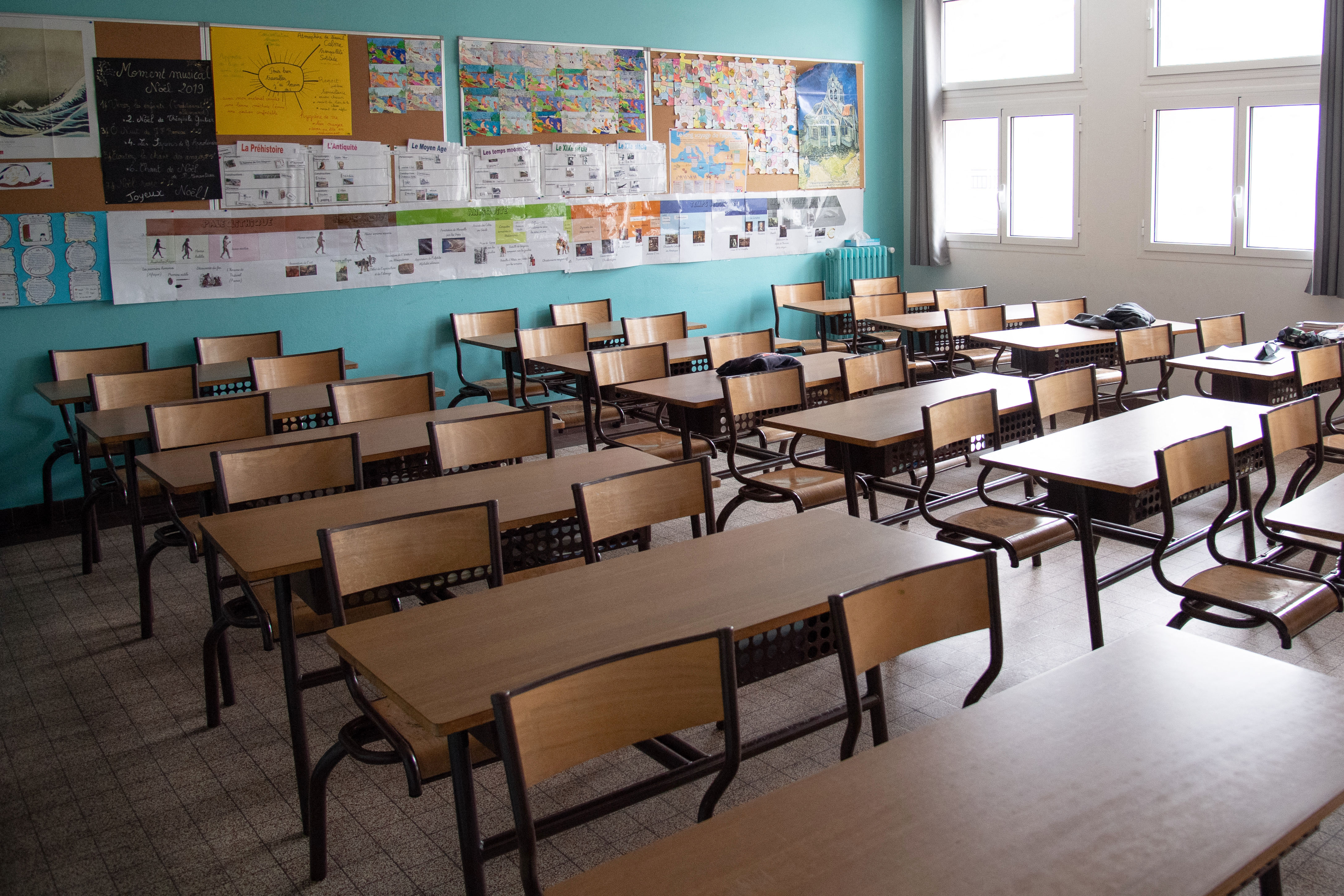 Shutting down businesses and schools felt to many people like a natural response to the COVID-19 pandemic. But the extended coronavirus lockdown of 2020 did not follow any widely-accepted standard strategy; lockdowns were sporadic and short-lived during the 1918 Spanish flu pandemic, the most recent historical parallel. Encouraging and coercing tens of millions of people to shelter in place in 2020 was one of the most radical social engineering experiments in modern history, as novel as the coronavirus itself.
Shutting down businesses and schools felt to many people like a natural response to the COVID-19 pandemic. But the extended coronavirus lockdown of 2020 did not follow any widely-accepted standard strategy; lockdowns were sporadic and short-lived during the 1918 Spanish flu pandemic, the most recent historical parallel. Encouraging and coercing tens of millions of people to shelter in place in 2020 was one of the most radical social engineering experiments in modern history, as novel as the coronavirus itself.
The political impulse to cancel events and close nonessential services we experienced during the spring and summer of 2020 is reemerging as the highly contagious, albeit anecdotally less severe, omicron variant sweeps through New York City and other hotspots. Broadway theaters, rock and hip-hop performers have canceled performances, the Rockettes closed their season a week early and Mayor Bill de Blasio is considering curtailing attendance at the city’s annual ball drop at Times Square. Rumors that New York City is considering another public-school system lockdown are sparking panic among parents.
Harvard has moved back to remote learning. The World Economic Forum in Davos has been canceled. Quebec is under lockdown, joining the Netherlands. The United Kingdom is considering one.
So, clearly, is the Biden Administration. The feds can’t order lockdowns. But they can pressure states and cities to enact them.
White House chief medical adviser Dr. Anthony Fauci says he doesn’t “foresee” another national lockdown in the United States—yet. Students of political messaging will take note of the careful if-then conditional sentence structure in Fauci’s statement on ABC’s “This Week”: “I don’t see that in the future if we do the things that we’re talking about,” Fauci said. “The thing that continues to be very troublesome to me and my public health colleagues is the fact that we still have 50 million people in the country who are eligible to be vaccinated who are not vaccinated.” What are the odds that vaccine resisters will change their minds in the next week or two?
Americans should consider, as we stare down the barrel of a second wave of “slow the spread”-motivated societal freezes, the pros and cons of the first one last year. Spoiler alert: this is not a movie that deserves a sequel.
Co-conceived in 2005 by the U.S. Department of Health and Human Services, Department of Homeland Security and the World Health Organization, the Pandemic Influenza Plan developed to “prevent, control, and respond to…novel influenza A viruses of animal (e.g. from birds or pigs) with pandemic potential,” according to the Centers for Disease Control, was the blueprint for the National Strategy for Pandemic Influenza deployed by the Trump and Biden administrations 15 years later to coordinate “all levels of government on the range of options for infection-control and containment, including those circumstances where social distancing measures, limitations on gatherings, or quarantine authority may be an appropriate public health intervention.” Federal officials turned to this Bush-era guidebook when COVID-19 came to America.
It pains this leftist to admit it, but conservatives who warned of the economic and psychological costs of the 2020 lockdown turned out to have been correct. “Lockdowns do not prevent infection in the future. They just don’t. It comes back many times, it comes back,” President Donald Trump said in April 2020, shortly before much of the country succumbed to lockdown fever. He looks prescient.
With the delta and omicron variants still raging, cost-benefit analysis of the COVID lockdown requires hard data that won’t be available for years. But one thing is clear: the lockdown experiment was far short of an unqualified success.
The economic cost has been staggering. “COVID-19–related job losses wiped out 113 straight months of job growth, with total nonfarm employment falling by 20.5 million jobs in April [2020],” according to a study by the Brookings Institute. 200,000 businesses more than average failed. Harvard economists David Cutler and Lawrence Summers have estimated the total cost of the crisis, much of which is attributable to the lockdown, at $16 trillion if the pandemic were to end this fall—i.e., now.
2020-21 was the Great Lost Year of American public education. With Black students five months behind where they would have been otherwise and whites two months back, virtual instruction was virtually educational.
But what about the benefit? Some studies claimed that lockdowns prevented nearly 5 million cases in the United States; at a mortality rate of 1.6% that works out to 80,000 fewer coronavirus fatalities thanks to the lockdown. But analyses of “excess deaths” indicate that at least 300,000 Americans more than usual died last year due to causes other than the virus itself. Increased alcohol consumption, reduced physical activity and depression culminating in suicide (not last year, when fewer people killed themselves, but in future years) will claim lives years into the future. If the lives-saved column of the ledger comes out a net positive, it probably won’t be by much.
As for ordinary Americans, we are voting with our feet: 72% of respondents to a December 14th Ipsos poll said they plan to see family or friends outside of their household over the holidays.
This country can’t handle more lockdowns.
(Ted Rall (Twitter: @tedrall), the political cartoonist, columnist and graphic novelist, is the author of a new graphic novel about a journalist gone bad, “The Stringer.” Order one today. You can support Ted’s hard-hitting political cartoons and columns and see his work first by sponsoring his work on Patreon.)
Follow Science or Your Weird Sky God
Liberal Democrats urge vaccine resistant Americans, particularly Republicans, to follow science and get vaccinated against COVID-19. Solid advice. But the very same liberal Democrats are willing to grant religious exceptions to vaccine mandates even though religion runs entirely contrary to science.
Employment Angst in the Time of Covid
American employers spent decades treating employees like crap. They slashed salaries, eliminated training, disrespected them, increased their working hours and then, when they were done with them, unceremoniously fired them in mass layoffs. Now they need more workers but people have moved onto their own businesses or family obligations instead.

